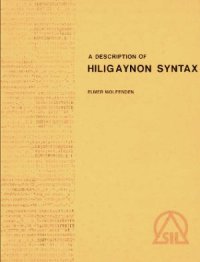
Ebook: A Description of Hiligaynon Syntax
Author: Wolfenden Elmer
- Genre: Linguistics // Foreign
- Tags: Языки и языкознание, Австронезийские языки, Хилигайнон, Hiligaynon, language, orthography
- Year: 1975
- Publisher: SIL
- Language: English
- pdf
Publisher: Benjamin F. Elson
Publication date: 1975
Number of pages: 188The description presented in the following pages accounts for the syntactic structure of Hiligaynon phrases and clauses by means of a modified tagmemic approach. Surface structure is described by the conventional tagmemic method, but an underlying structure is also recognized and described here by a modified tagmeme concept.
The underlying structure consists of patterns of correlation between semantic and grammatical functions. The semantic functions are what Fillmore refers to as case relationships such as agent and goal. In this study I retain the earlier tagmemic designation of situational role meanings. These semantic functions correlate in the underlying structure with grammatical functions such as subject and object. The correlations are different from Fillmore's case frames, however, since the case functions are here matched with grammatical functions.
The modification produces two benefits. First, recognition of an underlying structure provides one way to show relationship between semantic and grammatical information. The second benefit is that grammatical functions can be discussed before they are related to surface forms and. thus, underlying relationships between contrastive surface structures are also seen. This is so because the underlying patterns turn out to be general statements of functional relationships which appear unchanged for sets of surface structures. That is, where conventional tagmemics emphasizes contrasting surface structures, an effort is being made here to show how those structures can be derived from underlying patterns which are common to more than one contrastive surface structure. This, in turn, shows relationships between those surface structures. This description emphasizes the latter benefit.
The patterns of correlation are shown to be signaled by the semantic content of word roots. An analysis of three hundred roots into classes is the basis of the description of the clause constructions. Changes in the correlations sometimes occur as a result of derivational transformations. In order to present the description in a uniform way, a notation is used for the underlying patterns which is similar to that used in conventional tagmemic formulas.
Publication date: 1975
Number of pages: 188The description presented in the following pages accounts for the syntactic structure of Hiligaynon phrases and clauses by means of a modified tagmemic approach. Surface structure is described by the conventional tagmemic method, but an underlying structure is also recognized and described here by a modified tagmeme concept.
The underlying structure consists of patterns of correlation between semantic and grammatical functions. The semantic functions are what Fillmore refers to as case relationships such as agent and goal. In this study I retain the earlier tagmemic designation of situational role meanings. These semantic functions correlate in the underlying structure with grammatical functions such as subject and object. The correlations are different from Fillmore's case frames, however, since the case functions are here matched with grammatical functions.
The modification produces two benefits. First, recognition of an underlying structure provides one way to show relationship between semantic and grammatical information. The second benefit is that grammatical functions can be discussed before they are related to surface forms and. thus, underlying relationships between contrastive surface structures are also seen. This is so because the underlying patterns turn out to be general statements of functional relationships which appear unchanged for sets of surface structures. That is, where conventional tagmemics emphasizes contrasting surface structures, an effort is being made here to show how those structures can be derived from underlying patterns which are common to more than one contrastive surface structure. This, in turn, shows relationships between those surface structures. This description emphasizes the latter benefit.
The patterns of correlation are shown to be signaled by the semantic content of word roots. An analysis of three hundred roots into classes is the basis of the description of the clause constructions. Changes in the correlations sometimes occur as a result of derivational transformations. In order to present the description in a uniform way, a notation is used for the underlying patterns which is similar to that used in conventional tagmemic formulas.
Download the book A Description of Hiligaynon Syntax for free or read online
Continue reading on any device:

Last viewed books
Related books
{related-news}
Comments (0)